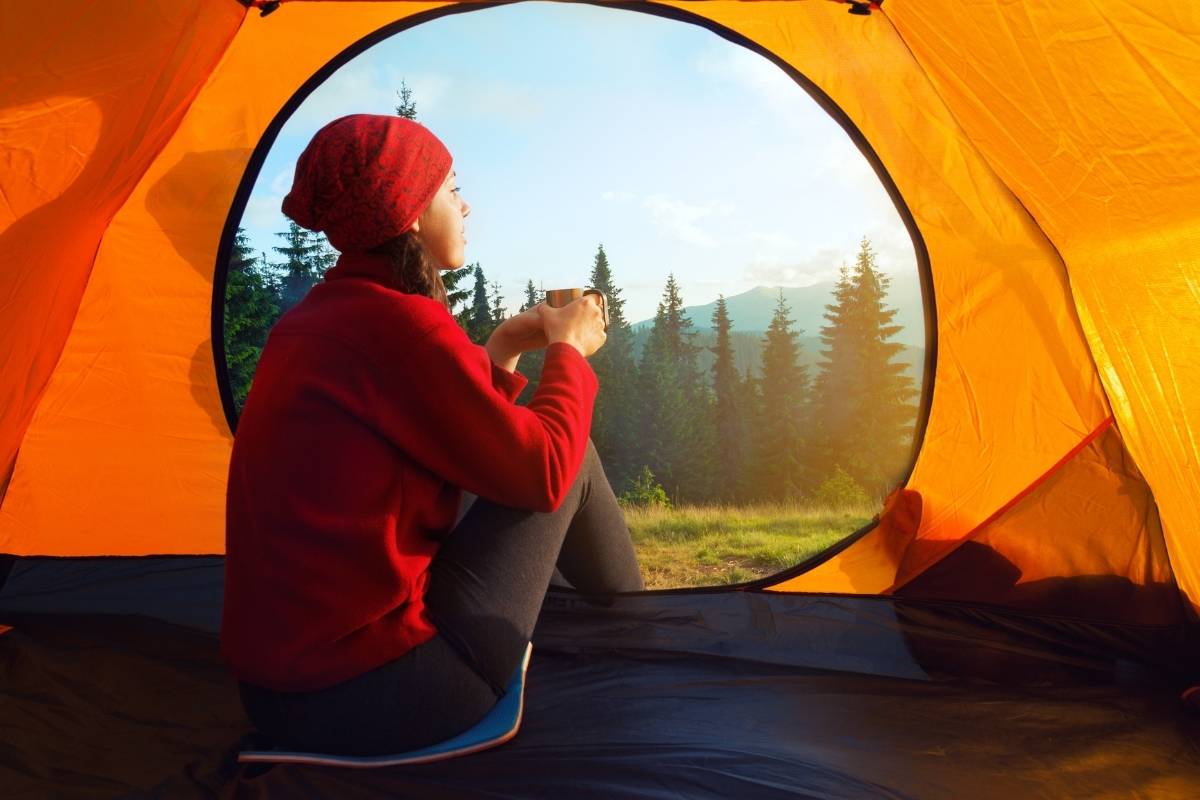One thing that many people overlook when they go camping is the position of their tent and, importantly, the direction that they pitch it.
To get the most from camping in a tent it is important to think about the tent direction so that you get the most daylight and least wind and weather.
The best direction to pitch a tent is an aspect that provides protection from the wind, while offering you the best opportunity to maximise light and sunshine. Ideally you should position the tent entrance downwind so that it is not facing into the wind. This will make it easier to get in and out of the tent and will also mean that the wind will not blast into the tent when you open the entrance, it will also help to keep the rain out if it is wet.
Table of Contents
Which direction should I pitch my tent?
This question has always sparked debate amongst campers, some campers prefer to pitch their tents to the east so they can watch the sun as it rises.
The rays from the sun wake them up so they can enjoy the view.
Other campers prefer to set up their tents with the door to the west. If you like to stay asleep through the early hours of the day, then this option is for you.
Moving forward, there are certain rules that should be respected by everyone when it comes to pitching a tent.
Do some homework before you leave
It goes without saying that even before you decide to go on a camping trip, you must first make sure that you are legally allowed to place your tent in the area you have chosen.
You don’t want to spend hours setting up a tent only to be removed later by the authorities or property owners.
Doing some research before you leave will help to avoid problems and will also help you to identify areas that are suitable for camping.
If the weather is bad or there are high winds a little investigation beforehand about the terrain could help reduce time spent when setting up.
You might find that your proposed site is unsuitable or is over exposed to the elements and time spent before you set off will prevent difficulties and frustrations later on.
Consider the wind when pitching your tent
The first thing you need to consider is the wind.
Light breezes that bring fresh air can be enjoyable but if it turns into a strong wind, it will be problematic.
Make sure to set up your tent in a sheltered area that is free from gusts and high winds.
Often you can tolerate a light breeze but, if you pitch your tent in an area that is persistently windy, you won’t put up with it for long.
Do not underestimate the wind, always make sure that you tent is pitched properly by using tent pegs and making sure lines are taut.
Remember that the wind can change quickly, particularly if you are at altitude or in an exposed coastal are, and , what started as a calm day, can rapidly change.
High winds can damage and destroy tents so always think about the wind potential and try to pitch in an area that offers some protection.
You should also make sure to place the door of your tent against the wind, if you place it in the direction of the wind, then the wind will blow in through the door.
At best it will just blow your contents everywhere, at worst your tent will act like a giant kite and could be blown away.

The terrain should be considered when choosing where to pitch your tent
The slope and type of land is also important.
Ideally you need the ground to be as level as possible and as clear as possible from stones and other debris.
The ground should be firm enough to hold your tent pegs securely, loose ground such as sand or gravel may provide a flat surface but, your tent pegs will struggle to grip and this may make erection of your tent tricky. You’ll also have trouble securing it properly against the wind.
If you are in an area where the ground slopes and you cannot access flat ground then always pitch your tent in a direction that allows you to lie down with your head higher than your feet.
Watch the trees when pitching your tent
Trees wil provide extra shelter and protection from wind, sun and rain and camping among them can be a great experience.
You’ll need to think carefully about your choice of pitch if you are in the forest or woods. Look out for dead trees or those that appear to be unstable.
If the wind gets up then there is a risk that the tree could fall or, more likely, that dead branches could drop.
Clearly this poses a risk both to your tent and to you.
Also give thought to the prospect of thunderstorms. These can be common in the summer and trees can act as natural lightening conductors.
If a tree close to your tent is struck by lightening then you could be in danger and at risk of injury or death.
So choose wisely.
Water sources
It can be really pleasant to set up your tent near to water but you’ll need to choose your pitch with care.
When choosing your pitch close to water think about:
Tidal – Is there a tide and will the water level change? If so then make sure that you are above the high water mark
Floods – Could the river or stream flood quickly if it rains? Remember that it could be dry and sunny where you are camping but, if it rains havily upstream then eventually that excess water will reach you. Flash floods catch out campers all the time. Make sure that you pitch your tent safely and above high flood levels
Insects and wildlife – water is a natural resource for animals and insects. If you are in an area where wildlife presents a safety risk then camping near to water might not be a great idea. Insects can also be prolific near to water sources and often they bite. You’ll need repellent, such as this one, to keep them away.
Final Words
With a little planning and forethought you should be able to select a comfortable, safe and secure pitch for your tent.
Always consider the basic principles, think about what could happen if you are near to water, and remember that the weather can and probably will change and take these things into account when selecting which way to pitch your tent.





